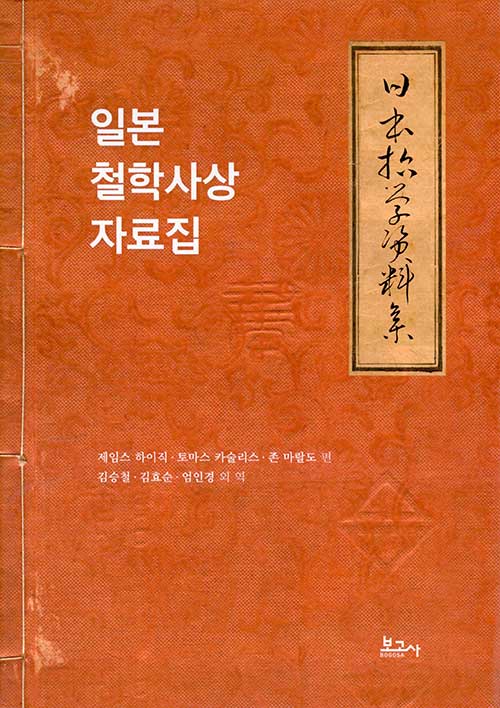일본 철학사상 자료집
제임스 하이직 (지은이),김계자 (옮긴이)보고사2021-10-20













정가
80,000원
판매가
76,000원 (5%, 4,000원 할인)
마일리지
4,000원(5%) + 멤버십(3~1%)
+ 5만원이상 구매시 2,000원

배송료
무료
수령예상일
지금 택배로 주문하면 8월 1일 출고
(중구 서소문로 89-31 기준) 지역변경
Sales Point : 101

이 책 어때요?
카드/간편결제 할인

무이자 할부

소득공제 3,420원

수량
장바구니 담기
바로구매
선물하기
보관함 +
전자책 출간알림 신청

중고 등록알림 신청

중고로 팔기




기본정보
양장본
1062쪽
목차
- 서장
- 불교전통
- 선불교
- 정토불교
- 유교
- 신도
- 근대 강단철학
- 교토학파
- 20세기 철학
- 문화와 정체성
- 사무라이 정신
- 여성 철학자
- 미학
- 생명윤리
저자 및 역자소개
제임스 하이직 (James W. Heisig) (지은이)
저자파일
신간알리미 신청
난잔대학 명예교수
최근작 : <일본 철학사상 자료집>
김계자 (옮긴이)
저자파일
신간알리미 신청
한신대학교 대학혁신추진단 조교수.
고려대학교 일어일문학과를 졸업하고 동 대학원에서 석사학위를 받은 뒤, 일본 도쿄대학 인문사회계연구과에서 일본문학으로 석·박사학위를 받았다. 일제강점기부터 해방을 거쳐 현재에 이르기까지 한일 문학이 관련된 양상을 통시적으로 살펴보고, 한국인의 일본어문학이 형성된 전체상을 밝히는 연구를 진행하고 있다. 주요 저역서에 『근대 일본문단과 식민지 조선』(역락, 2015), 『일본대중문화의 이해』(공저, 역락, 2015), 「김석범 장편소설 1945년 여름」(보고사, 2017) 등이 있다.
최근작 : <일본의 근대, 근대의 일본>,<역사 속의 한류>,<지식의 쓸모를 찾아서> … 총 27종 (모두보기)
=======

 See this image
See this imageFollow the AuthorsSee all

John C. Maraldo
Follow

James W. Heisig
Follow
Japanese Philosophy: A Sourcebook (Nanzan Library of Asian Religion and Culture, 5) Paperback – Illustrated, July 31, 2011
by John C. Maraldo (Editor), Thomas P. Kasulis (Editor), James W. Heisig (Editor)
4.7 4.7 out of 5 stars 53 ratings
4.4 on Goodreads
35 ratings
Part of: Nanzan Library of Asian Religion and Culture (6 books)
See all formats and editions
Kindle
$25.00Read with Our Free App
Paperback
$29.94
5 Used from $25.006 New from $45.99
With Japanese Philosophy: A Sourcebook, readers of English can now access in a single volume the richness and diversity of Japanese philosophy as it has developed throughout history. Leading scholars in the field have translated selections from the writings of more than a hundred philosophical thinkers from all eras and schools of thought, many of them available in English for the first time.
The Sourcebook editors have set out to represent the entire Japanese philosophical tradition―not only the broad spectrum of academic philosophy dating from the introduction of Western philosophy in the latter part of the nineteenth century, but also the philosophical ideas of major Japanese traditions of Buddhism, Confucianism, and Shinto. The philosophical significance of each tradition is laid out in an extensive overview, and each selection is accompanied by a brief biographical sketch of its author and helpful information on placing the work in its proper context. The bulk of the supporting material, which comprises nearly a quarter of the volume, is given to original interpretive essays on topics not explicitly covered in other chapters: cultural identity, samurai thought, women philosophers, aesthetics, bioethics.
An introductory chapter provides a historical overview of Japanese philosophy and a discussion of the Japanese debate over defining the idea of philosophy, both of which help explain the rationale behind the design of the Sourcebook. An exhaustive glossary of technical terminology, a chronology of authors, and a thematic index are appended. Specialists will find information related to original sources and sinographs for Japanese names and terms in a comprehensive bibliography and general index.
Handsomely presented and clearly organized for ease of use, Japanese Philosophy: A Sourcebook will be a cornerstone in Japanese studies for decades to come. It will be an essential reference for anyone interested in traditional or contemporary Japanese culture and the way it has shaped and been shaped by its great thinkers over the centuries.
Read less
Report incorrect product infor
Review



